Along Mexico’s Independence Trail
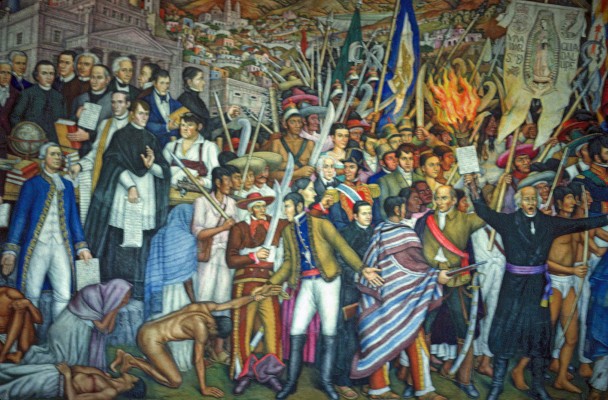
Mural by Juan O´Gorman, National Museum of History, Mexico City depicts Father Miguel Hidalgo and the Grito de Dolores, marking the start of Mexico’s struggle for independence
On a mountaintop near Guanajuato, a gigantic statue of Christ stands on the spot that locals say marks the center of Mexico. Its significance is more than geographic. It also pierces the heart of three hundred years of Mexican history. Here, in an area of less than one hundred miles, many of the most significant, turbulent, heroic and bloody events in Mexico’s history took place.
Today, the towns that were the setting for most of the drama — Guanajuato, San Miguel de Allende, Dolores Hidalgo, and Queretaro — are known as the Cradle of Independence. Even though there is modern development around them, so much of their heart has remained intact since their colonial heyday, visiting them is akin to reliving their history.
Within twenty years after Cortes had landed at Veracruz in 1519 and conquered the Aztecs, the Spanish had established the most powerful empire in the New World, securing the countryside with a vanguard of soldier-priests who maintained a chain of missions that were, more accurately, military outposts.
The Silver Streak
Yet these early events paled into insignificance when silver was discovered in 1546 in Zacatecas in the north central part of Mexico. Soon after, silver was located in dozens of places in the two hundred miles north of Queretaro (in the region known as the Bajio), and for the next three centuries a river of silver flowed from the hills and valleys into Spain’s royal treasury to make her the richest, most powerful nation in the world. So important was the silver trade that the economy, security, transportation, and communications of Mexico were organized around silver to the exclusion of almost everything else—a colonial legacy from which the modern country was still recovering.
To keep the silver moving, the Spaniards had to use forced labor, turning the indios, or natives, into slaves in everything but name. Shantytowns sprang up around the mines, and a series of way stations and military outposts were developed along the silver route.
As wealth was accumulated, these places developed into towns and cities with palatial mansions built by administrators and poor men who became millionaires overnight, erecting and embellishing churches in gratitude for their good fortune. One such miner is said to have become so rich that the mortar used to build his house was mixed with silver.
The large towns, such as Guanajuato, became centers of banking, power, and an opulent, glamorous society. By the eighteenth century, Guanajuato had become the second largest city in North America, and the richest. Even as late as 1903, Guanajuato’s new opera house drew the world’s most famous stars and a glittering assembly of European nobility for its opening.
Touches of Class
But as the eighteenth century ended (and the mines began to play out), so too did the endurance of the Mexicans. Two classes, created by the stratified colonial society, were ready to unite, despite their longstanding hostility.
For three hundred years, the criollos, Spaniards born in Mexico, had smarted under the inequities of the rigid system imposed by Spain that kept them from enjoying the same benefits as the gachupines, the ruling elite sent from Spain. The mestizos, the descendants of mixed Spanish, other European, and Indian blood, who had been forced to take the most menial jobs, had by now become the largest group in New Spain. In the frontier of the Bajio, where the harsh lines of colonial society were blurred, mestizos had the rare opportunity to make money and to advance. If a man’s skin were light enough and he made enough money, after several generations his descendants would come to be accepted as criollos.
The almost total absence of a reform movement in the face of the oppressive colonial system is explained by the fact that the impact of Spaniards and their annihilation of the Indian culture had been so great that intellectually Mexico remained in a state of shock throughout most of the colonial period. But, it was only a matter of time before the new society acquired a momentum and a direction of its own. In the Bajio, where wealth had been the most extravagant, power the most naked, and oppression the most deliberate, revolution was to be most violent.
Rumbles of Revolution
The nineteenth century opened with Mexico in ferment as waves of the French and the American revolutions washed over it. In Europe, the Spanish monarchy, weakened by seemingly endless wars, collapsed when the French invaded Spain in 1808. Napoleon completed the insult by putting his brother Joseph on the Spanish throne, but the Spaniards refused to recognize him. In Mexico, the criollos conspired to break away until legitimacy could be restored to the throne, only to be checkmated by the gachupines, who were afraid of losing control.
In the meantime, groups of conspirators made up of criollos and led by an officer in the royal regiment, Ignacio Allende of San Miguel, and a parish priest from Dolores, Miguel Hidalgo, were hatching a revolutionary plot in Queretaro. Allende, the practical military man, had limited objectives, namely, to get rid of the gachupines and to seize power for the criollos. Hidalgo, on the other hand, was the dreamer filled with the noble ideals of the French Revolution. He believed the movement had to be a popular uprising.
A Key Message
Originally, the action was to start in December 1810, but rumors of the plot reached the authorities, and on September 14, an arms cache was seized in Queretaro, and orders went out for the arrest of the known conspirators. While the magistrate of Queretaro, an undiscovered conspirator, wrestled with the problem of arresting his friends, his wife — known in history as La Corregidora — whispered a message through the keyhole of her locked room (where her husband had put her to keep her from causing trouble) that was rushed to Allende and Hidalgo, warning them of the danger.
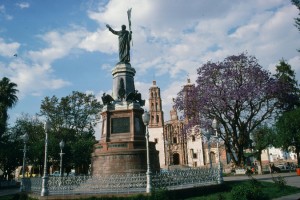 Allende counseled the leaders to go into hiding, but Hidalgo insisted the time had come for action. He rang his church bells to summon the people to arms. The event, known as the Grito de Dolores, the Cry, marks the start of Mexico’s Independence Day celebration when at 11 p.m. on September 15, in the main plazas of towns throughout the country, the country’s flag is unfurled and the crowds shout, “Mexicanos, viva Mexico.”
Allende counseled the leaders to go into hiding, but Hidalgo insisted the time had come for action. He rang his church bells to summon the people to arms. The event, known as the Grito de Dolores, the Cry, marks the start of Mexico’s Independence Day celebration when at 11 p.m. on September 15, in the main plazas of towns throughout the country, the country’s flag is unfurled and the crowds shout, “Mexicanos, viva Mexico.”
With his ragtag army, the gun-toting priest marched on Guanajuato, pausing at the Indian shrine of Atotonilco long enough to take the icon of the Virgin of Guadalupe, which he affixed to his standard, and moving on to San Miguel and Celaya, gathering supporters, arresting gachupines, and collecting their weapons along the way.
Tranquil Terrain Today
The rebellion marked the Spaniards’ first defeat, and although it took another century for the Mexicans to realize true independence, it set in motion a course of events that was to change the country forever.
Today, the route from Guanajuato to Dolores Hidalgo, San Miguel and Queretaro, known as the Independence Trail, is so tranquil it is difficult to imagine the ferocity of the events that took place here. El Bajio, as the Guanajuato Basin is called, is the largest of seven valleys that make up the high, central plateau of Mexico and encompasses most of its richest farmlands. The plateau is five thousand to six thousand feet above sea level — although it never seems to be so high — and accounts for the region having one of the most pleasant, year-round spring-like climates in the Western Hemisphere. No wonder the Spaniards liked it!
The terrain in some parts is even reminiscent of Spain. There are no majestic mountains like those found farther south in the area of Mexico City, but undefined, brooding mountains off in the distance across vast cultivated flatlands. In some places the mountains are covered by forests, but more often the greenery is struggling shrub interrupted by jagged rock outcroppings.
Near the heart of the historic region, the great expanse is broken by tightly fitted ravines with little villages folded into their pockets. It was in one of these ravines, where the Rio Guanajuato flowed, that the city of Guanajuato got its start.
Finding Old Guanajuato
Today, Old Guanajuato is a city caught in time. Snug within a ravine, it looks as though its architects had copied the houses of an Italian Riviera town but added a Mexican touch by painting them in strong, bright colors, rather than in Mediterranean pastels.
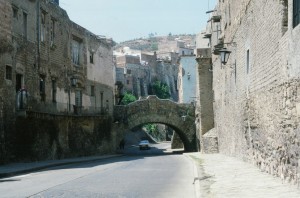 The old city stretches along the ravine, and in lanes so narrow two people cannot walk abreast, it climbs up the sides of the ravine through which the river once flowed. After a devastating flood in 1905 that sent the town and half of its population tumbling downstream, the river’s waters were diverted. The river bed was filled and underground sewers built of heavy stone masonry, dating from the seventeenth century, were made into an underground tunnel for motor traffic, thus enabling the old city to remain relatively intact.
The old city stretches along the ravine, and in lanes so narrow two people cannot walk abreast, it climbs up the sides of the ravine through which the river once flowed. After a devastating flood in 1905 that sent the town and half of its population tumbling downstream, the river’s waters were diverted. The river bed was filled and underground sewers built of heavy stone masonry, dating from the seventeenth century, were made into an underground tunnel for motor traffic, thus enabling the old city to remain relatively intact.
Jardin de la Union is the small square in the heart of town where many of the most historic attractions are located. This active plaza features an old-fashioned bandstand, tiled pavements, and ornate wrought-iron benches. Along its streets are many old churches and palatial mansions that now house offices, banks, and stores. Standing as testimony to the town’s mining booms, the Teatro Juarez is an elaborately ornate building with carved muses gracing the doorway, gilt carvings and velvet fabrics adorning the interior, and graceful art-nouveau railings lining the various tiers and balconies.
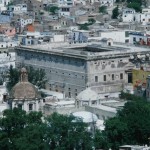 Guanajuato was the center of the first skirmishes of the Mexican revolution. It was here, on September 16, 1810, that the motley band of revolutionaries, 12,000 strong and led by Miguel Hidalgo, first engaged their Spanish overlords. They surrounded the loyalists’ stronghold, which was the town granary, Alhondiga, an impenetrable fortress in the center of the city. In an act of desperate courage, a miner from San
Guanajuato was the center of the first skirmishes of the Mexican revolution. It was here, on September 16, 1810, that the motley band of revolutionaries, 12,000 strong and led by Miguel Hidalgo, first engaged their Spanish overlords. They surrounded the loyalists’ stronghold, which was the town granary, Alhondiga, an impenetrable fortress in the center of the city. In an act of desperate courage, a miner from San 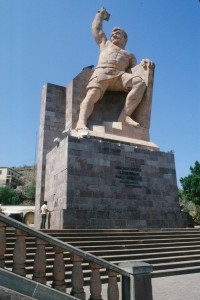 Miguel — to be known in history as Al Pipila — tied a stone to his back to protect himself from bullets and molten lead and made his way to the fortress gate, where he set its doors on fire, thus enabling the frenzied mob to enter. Mayhem followed. The Spaniards were massacred; hundreds of people were killed.
Miguel — to be known in history as Al Pipila — tied a stone to his back to protect himself from bullets and molten lead and made his way to the fortress gate, where he set its doors on fire, thus enabling the frenzied mob to enter. Mayhem followed. The Spaniards were massacred; hundreds of people were killed.
The people’s revolt — the first in Mexican history — lasted less than a year. By the time the federal forces had retaken the city, Hidalgo and the other leaders had fled north where in Chihuahua they were captured, tried, and beheaded. The viceroy, in retribution and to caution anyone else with revolutionary fever, brought the severed heads of Hidalgo, Allende, and two other rebel leaders to Guanajuato and hung one on each corner of the Alhondiga, where they remained for ten years. The hooks are still there as a grim reminder.
A Poignant Tribute
In a corridor of the Alhondiga, now the beautifully restored state museum, four consecutive rooms — each bearing the name and bronze likeness of the four heroes of the Independence — are immortalized by the light of an eternal flame. Both the context and juxtaposition make this one of the country’s most eloquent monuments. In contrast to the quiet 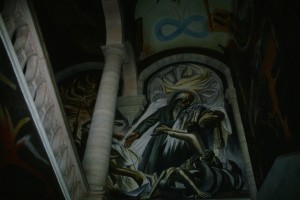 dignity of the memorial, the walls of the museum’s stairways are covered with the strident murals of Jose Chavez Moredo, in the best tradition of Mexican muralists.
dignity of the memorial, the walls of the museum’s stairways are covered with the strident murals of Jose Chavez Moredo, in the best tradition of Mexican muralists.
A cultural focal point for the town, the University of Guanajuato, the second most important in Mexico, was begun in 1732 as a Jesuit school. Its students are noted for their performances of Entremeses, witty sketches, most written nearly four hundred years ago by Miguel Cervantes, performed outdoors in the spring. The Entremeses gave rise to the Cervantes Festival held every October. It is the premier cultural festival in Mexico, attracting performers from around the world.
Also near the plaza is the house of Diego Rivera, Mexico’s most famous muralist. Because of his Marxist sentiments this conservative town did not think much of its native son during his lifetime, but his house is now a museum.
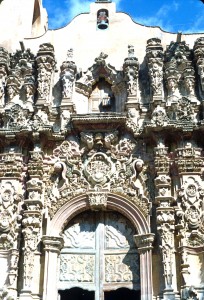 Valenciana, a suburb of Guanajuato, is well worth a short bus trip or taxi ride because of its beautiful church and rich silver mine. Across from the mine entrance is La Iglesia de San Cayetano (known as La Valenciana), built by the mine’s owner. Constructed of rose-colored stone, its imposing Churrigueresque entrance and bell tower stand out against the blue Mexican sky. Inside, three huge altars, heavily trimmed with gold leaf, are adorned with delicately carved angels and cherubs.
Valenciana, a suburb of Guanajuato, is well worth a short bus trip or taxi ride because of its beautiful church and rich silver mine. Across from the mine entrance is La Iglesia de San Cayetano (known as La Valenciana), built by the mine’s owner. Constructed of rose-colored stone, its imposing Churrigueresque entrance and bell tower stand out against the blue Mexican sky. Inside, three huge altars, heavily trimmed with gold leaf, are adorned with delicately carved angels and cherubs.
The drive from the grand heights of La Valenciana to the Church of the Miners in the valley is symbolic. The miner’s church is small and though its Churrigueresque facade is elaborate; the beautiful interior is as simple 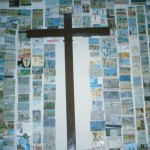 as La Valenciana is ornate. Two walls are covered with retablos, small votive paintings on wood or metal, whose stories are told with such sensitivity and frankness that they become their own testimony of the miner’s suffering. These alone are worth the trip to Guanajuato.
as La Valenciana is ornate. Two walls are covered with retablos, small votive paintings on wood or metal, whose stories are told with such sensitivity and frankness that they become their own testimony of the miner’s suffering. These alone are worth the trip to Guanajuato.
The famous mummies of Guanajuato have their own museum. In hilly Guanajuato, the dead are often tucked away in church walls, there being little flat space for graveyards. It is in the walls that some corpses mummify, and when perpetual space is not paid for, bodies are removed after seven years. The mummies were not carefully wrapped, as their 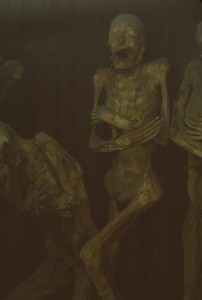 Egyptian counterparts were; instead, they appear in the same state as at the time of death, dressed or undressed. Grotesque now, they resemble live people with dried shriveled skin who have been tortured. Apparently, the dryness of the air and chemical composition of the earth somehow prevent the body from decomposing. (http://www.momiasdeguanajuato.gob.mx)
Egyptian counterparts were; instead, they appear in the same state as at the time of death, dressed or undressed. Grotesque now, they resemble live people with dried shriveled skin who have been tortured. Apparently, the dryness of the air and chemical composition of the earth somehow prevent the body from decomposing. (http://www.momiasdeguanajuato.gob.mx)
An Unusual Cultural Scene
Continuing in a triangle along the Colonial Route, the road north from Guanajuato leads to Dolores Hidalgo, the name of a city and the surrounding municipality. Known simply as Dolores, the small town was renamed Dolores Hidalgo after Mexico gained its independence to honor Father Miguel Hidalgo whose famous cry, Grito of Dolores, in 1810, is commemorated as the start of Mexico’s independence struggle. On the main plaza outside the parish church stands the statue of Hidalgo. The Museum of Independence is next to the square.
Today, Dolores Hidalgo with a population of 60,000 people, is known primarily for its colorful and elaborately-designed ceramics, which is said to provide income to over half the city’s population. The town is also famous for its exotic ice cream flavors, such as beer or mole (chili and chocolate sauce) which you can buy from vendors at the main square.
Turning south, the road continues to San Miguel de Allende at 6,000 feet altitude and surrounded by the beautiful Sierra Madre mountains. The town became an intellectual center for expatriate Americans when Sterling Dickenson opened his school, Instituto Allende, in 1938. As a result, San Miguel de Allende at one time attracted a large and rather notable North American community, including Gerald Greene (Holocaust) and Clifford Irving (The Hoax) among the writers in residence. Almost any social gathering might have included a painter or a concert artist and perhaps an actor or two. Today, year-round courses are given in painting, sculpture, ceramics, photography, and Mexican and Latin-American literature. The School of Art offers B.A. and A.A. degrees in Visual Arts, accredited through the University of Guanajuato; http://instituto-allende.edu.mx
The center of town, now a UNESCO World Heritage site, is the Plaza Allende, and crafts shops, art galleries, and cafes are scattered within easy walking distance around it. The plaza is dominated by a nine¬teenth-century church, La Parroquia, which is probably the most unusual in Mexico. The architect, Ceferino Gutierrez, was a self-educated Indian, who, as the story goes, conceived of the structure from postcard reproductions of European churches. The soaring steeples of this Gothic-spired (and inspired) church are San Miguel’s landmark.
Near the plaza, the Centro Cultural Ignacio Ramirez, once a convent, is a branch of the Instituto de Bellas Artes of Mexico City and offers courses in drawing, painting, textiles, ceramics, dance, and guitar. Its buildings also house a small museum with a good collection of pre-Columbian art. In the town itself, the beautiful Spanish buildings still stand, and cobblestoned streets of the colonial period are in good condition. Since the streets in the old areas are narrow and steep, the best way to traverse them is to walk. The countryside around San Miguel is famous for health spas with hot springs and for one of the world’s finest riding schools, Escuela Ecuestre.
Amazing Space
An hour’s drive south of San Miguel de Allende, Queretaro was an important crossroads in Mexican history, as can be seen by visiting the Museo Regional de Queretaro. The most interesting historical items in the museum include the keyhole and door latch of the house where La Corregidora was held captive.
Queretaro is also the place to see some of Mexico’s best examples of ecclesiastical architecture. The Church of Santa Rosa de Viterbo is one of the most exotic. Completed in 1737, the church has two enormous flying buttresses that help shore up the central structure, upon which an octagonal cupola is set. An intricate bell tower, the top of which is fashioned after an Oriental pagoda, points magnificently toward the sky. The outermost extremities of the flying buttresses, which extend from the tower to the street, are flanked by ornately-carved dragon faces. Inside, the Santa Rosa church contains enormous retablos.
The Historic Downtown of Queretaro is also a UNESCO World Heritage Site but today, it’s the most modern of the three cities and claims the distinction of being the first city in Latin America to be wireless. Its ultra-modern arts center, Palacio Artes Queretaro, is not to be missed.
The state of Queretaro, although relatively small, is well worth exploring, surrounded by the mountains of the Sierra Madre Occidental and Sierra Gorda and offering hiking, climbing, caving and bird watching, to name a few activities. In addition to its rich history, it is home to the Sierra Gorda Biosphere Reserve, one of the most interesting nature reserves in Mexico.
© By Kay Showker

Leave a Reply